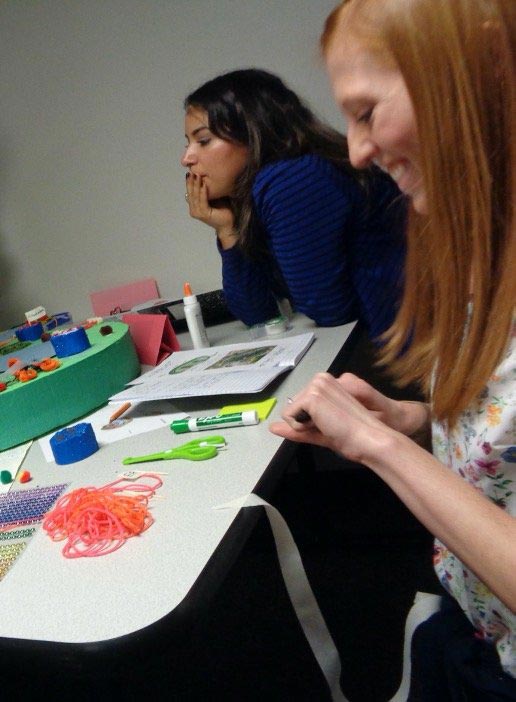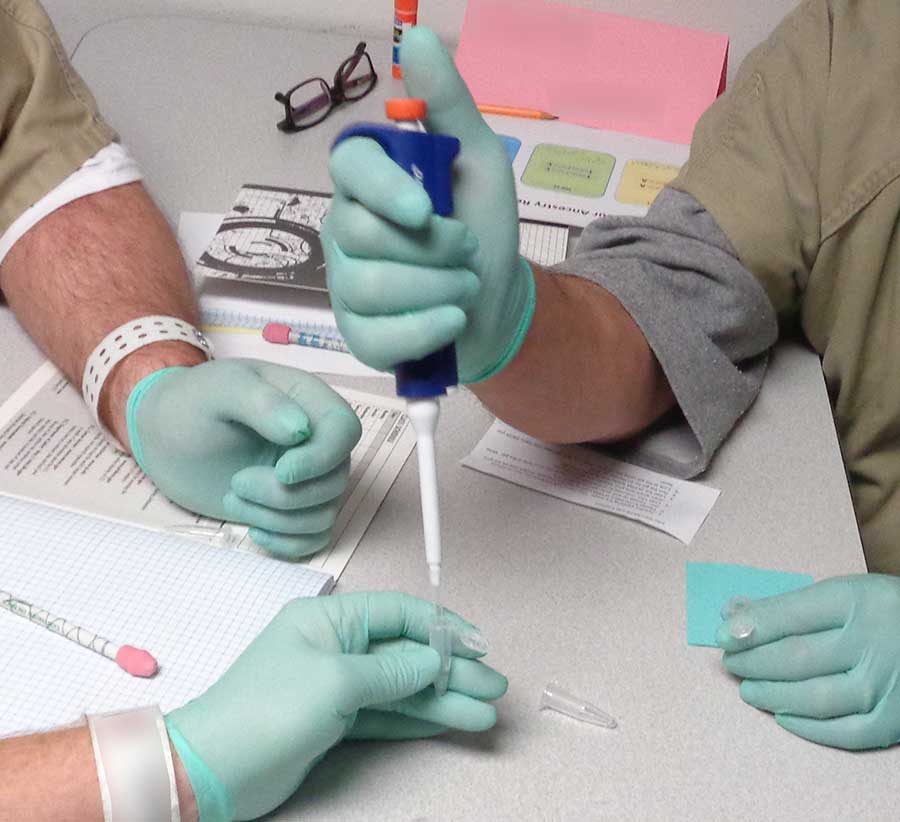By:
- Mario C. Aguilera
Published Date
By:
- Mario C. Aguilera
Share This:

Members of the BioEASI jail science class program include (from left): Abigail Gillespie, Anna Guzikowski, Laura Beebe, Beverly Naigles, Alana Gibson, Julie Paxman, Beto Vasquez and Gabriela Goldberg.Photo taken prior to the start of the COVID-19 pandemic.
Grad Students Build Science Bridge to the Incarcerated
Nontraditional community outreach project offers life-changing connections through science education
They departed from the familiar confines of one of San Diego’s major institutions and arrived at a decidedly different one.
In December of 2018, a handful of UC San Diego graduate students left their habitual classrooms, research labs and cool coastal breezes in faraway La Jolla and—brimming with enthusiasm and anticipation—stepped into the unknowns of the East Mesa Re-Entry Facility in South San Diego.
Led by fourth-year graduate student Beverly Naigles, this unusual education and outreach project—a science class for incarcerated adults—was developed to connect two groups that rarely cross paths. One key piece of the program was set in stone from the start. The project would not be a one-way stream of information from the graduate student educators to the incarcerated students in jail. Rather, they built in the idea of a reciprocal relationship.
“It was really important to us that we approached this project as a knowledge exchange—not like we are going to come in and teach you everything,” said Naigles. “We had the mindset that we are going to come in and learn with you—so it’s important to us that we are appreciating the knowledge that they are bringing.”
What they didn’t know, as they stepped inside the jail facility that first day, was how relationships would build and evolve, and how their views on science and education would change forever.
Where the need is greatest
When Naigles arrived at UC San Diego for graduate training in quantitative cell biology, she burned to do something that stood apart from traditional community science outreach projects designed for young minds. She believes that there is an intrinsic value to people of all ages learning about science, and science outreach can go beyond encouraging kids to become scientists. She wanted to develop a program that put that belief into action to empower communities.
She connected with Bio Education and Art for Science Innovation, or “BioEASI,” a Division of Biological Sciences and Salk Institute graduate student group that fosters interactions between scientists and the public. BioEASI is designed to increase public interest in science and at the same time enhance early career scientists’ communication skills.
As an undergraduate at Brown University and while considering graduate school at the University of Washington, Naigles was inspired by community outreach projects in which researchers offered science education at jails and prisons. The idea stuck with her. After linking with BioEASI, she set out to develop a program in San Diego for adults far removed from the scientific literacy found in areas such as La Jolla, and deliver science where the need was greatest. She set her sights on the East Mesa Re-Entry Facility (EMRF).

A student participating in a graduate student-led science class displays a model of a plant cell created during a class focusing on cellular structure and function.
Naigles and five fellow graduate students made it through their first day at the EMRF and went on to lead six bi-weekly lessons focusing on the science of DNA from January to March of 2019 to a group of men convicted of non-violent crimes. Building on the momentum of the pilot phase, the group continued to run classes each quarter to groups of 16 students on average ranging in age from 18 to 70. Topics have spanned from genetics to marine biology to nutrition. Earlier this year, the program expanded to include Spanish science classes at EMRF and an initial science class for women at the Las Colinas Detention and Re-Entry Facility in Santee.
In all, 20 graduate student instructors, each required to complete six hours of jail facility orientation before stepping inside, have worked with nearly 90 incarcerated students. And now, the American Society for Cell Biology, through funding from Science Sandbox, an initiative of the Simons Foundation, has put forth support to continue and expand the program through a $31,000 grant.
Fourth-year neurobiology graduate student Alana Gibson, co-director of the program, got involved because of her longstanding interest in the nation’s correctional facilities.
“I have a lot of thoughts about the justice system—I think there’s a lot of room for improvement,” said Gibson. “I love sharing science with the community and this seemed like a great way to share science with a part of the community that is usually not included in STEM. On the flipside, it also provides some engagement and intellectual stimulation for them. It just sounded like an amazing idea.”
Relationships built through science
Getting the jail science project off the ground required more than the intellect of budding biologists. In order to successfully roll out the program, the project leaders needed counsel and strategic support from someone who knew the ins and outs of UC San Diego research as well as the jail system.
Those invaluable perspectives came from Alberto “Beto” Vasquez and UC San Diego’s Center for Research on Equity, Assessment and Teaching Excellence, or CREATE, an equity-centered research program that links campus and community members and leverages university resources. As an academic coordinator for CREATE, Vasquez, a Division of Biological Sciences alumnus, offered the graduate students insights to effectively reach underserved communities in San Diego and connect with their new students. But he also brought an insider’s perspective of the jail system, its occupants and culture, having spent time as an inmate in state prisons.

Former science class co-director Julie Paxman (right) and Daniela Zárate (left) work with students to build a model of a cell during a class on cell biology at the East Mesa Re-Entry Facility.
“The vision for this program really was not only to serve students and promote science literacy, but from our standpoint in CREATE, it was pretty exciting to provide an opportunity for graduate students to go into an environment that is very different from what they are used to,” said Vasquez. “For me, it was exciting to see them challenge expectations, not only about the students in jail but about themselves.”
Naigles faced the challenge of stepping into a different world with an open mind.
“Many of our (incarcerated) students are people who I would not come into contact with living my usual life, so it’s really cool to get to know people who have landed in different situations than me, and to get to talk to them, hear about what they want to do when they get out, learn from their experiences and hear their questions,” said Naigles, who added that the project and exposure to people with vastly dissimilar life experiences has made her rethink not only her personal interactions, but science itself.
A student who worked as a commercial fisherman, for example, brought unique perspectives to the marine science class. Other viewpoints on topics such as genetic editing in humans have made the graduate students take pause. They have learned from the creativity through which the students tackle activities, such as designing creatures adapted to a hypothetical environment. They also learn from their students’ questions, which range from sleep to smell to the brain and fluid intake.
“The students make me think differently about biology, so that’s been really rewarding,” said Naigles. “We don’t always think about science as a way to build relationships. As the leader of this program it’s been super rewarding to see that happen.”
A spark sets off
For Gibson, the most recent class—just before COVID-19 put the program on hold (remote classes are in the works)—was a seismic shift from entering the jail facility on that first day. As time passed, session after session, science topic after topic, the graduate student’s relationships with the students flourished.
“The students on the very first day usually have their arms crossed. They are a little wary of us and closed off,” said Gibson. “But as it goes on, when they realize that we are volunteering and we do want to be there, and we are treating them like humans, then they start warming up to us and feeling more comfortable. They start feeling that this is something that they actually want to be attending and participating in—that’s one of the most rewarding things to see.”
With 13 years of correctional re-entry experience, Patricia Ceballos views the science program from the jail system’s perspective. A member of the San Diego County Sheriff’s Department since 2014, the past two years serving as reentry services assistant manager, she sees the science program as a golden opportunity for the incarcerated.
She has worked with other colleges in the jail system, but the UC San Diego science class is one of the first in-person science classes they’ve been able to offer to inmates. She says it has drawn out a different side from them.

Science class students at the East Mesa Re-Entry Facility pipette during a class on human genetics, part of a unique program developed by UC San Diego Biological Sciences graduate students.
“I’m very fortunate to have taken the UCSD science class here at EMRF,” said a student identified as Christopher F. “The instructors were not only informative in teaching the curriculum, but passionate in giving us the confidence to pursue high education for a better life. Positive thoughts manifest positive outcomes.”
According to Ceballos, science has begun to offer them a new path to view the world and the future, beginning with a sense of empowerment connected with the science class experience.
“When you start to widen that lens for them and when they can see the opportunities come up— that they can fit into society—it helps them tremendously,” said Ceballos. “We see an elevated sense of confidence. There is this spark that sets off inside them, wanting to learn and see what’s possible.”
Vasquez’s first-hand knowledge of both worlds provides a perspective that the class is hitting upon something deeper than a knowledge exchange. When the classes resume, the short-term goal of the program is to continue to increase the students’ engagement with science by offering vouchers to attend classes at UC San Diego Extension upon release. In the long run, the goal is to build a pipeline from jail to higher education.
“We can say we have a great program but the truth is it’s a little deeper than that,” said Vasquez. “We are recognizing that there is a need for innovative strategies to continue to support our students and real-life experiences. But at the same time, we are able to provide a service and potentially change the life of these individuals who have made bad decisions but have the capacity to move somewhere else and do something different with their lives, as I have.”
Members of the BioEASI science class project:
Brooke Anderson, Gabriel Ascui, Emily Baltz, Laura Beebe, Patrick Bruck, Jillybeth Burgado, Daniela Cassataro, Antonia Darragh, Cong Dinh, Alana Gibson (program co-director), Abigail Gillespie, Gabriela Goldberg, Anna Guzikowski, Daniel Heinz, Vivian Ko, Beverly Naigles (program founder, co-director), Conor O’ Herin, Alexandria Palaferri-Scheiber, Julie Paxman (former co-director), Regina Powers, Meghan Rossi, Cedric Snethlage, Lee Swanson, Alberto Vasquez and Daniela Zárate.
Philanthropic gifts—like this grant from the American Society for Cell Biology through funding from Science Sandbox, an initiative of the Simons Foundation—contribute to the Campaign for UC San Diego, a university-wide comprehensive fundraising effort concluding in 2022. Alongside UC San Diego’s philanthropic partners, the university is continuing its nontraditional path toward revolutionary ideas, unexpected answers, lifesaving discoveries and planet-changing impact. To learn more about supporting Biological Sciences at UC San Diego, visit biology.ucsd.edu/giving.
Share This:
You May Also Like
Endowed Director’s Chair in Cardiovascular Rehabilitation and Wellness Established at UC San Diego
GivingStay in the Know
Keep up with all the latest from UC San Diego. Subscribe to the newsletter today.



